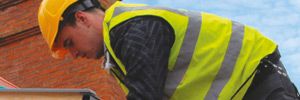 A new guide to the recently updated ?BS 5534:2014 for Slating and Tiling for pitched roofs and vertical cladding – Code of Practice’ has been published to assist specifiers, roofing contractors and builders’ merchants on the key changes that came into effect on March 1, 2015.
A new guide to the recently updated ?BS 5534:2014 for Slating and Tiling for pitched roofs and vertical cladding – Code of Practice’ has been published to assist specifiers, roofing contractors and builders’ merchants on the key changes that came into effect on March 1, 2015.
Written by John Dodd, director of John Dodd Consulting and chairman of the BSI Committee B/542/1 responsible for the drafting of BS 5534:2014, the revised standard covers the design, materials, application, installation and performance criteria affecting the use of slates, tiles, shingles and shakes on pitched roofs and vertical cladding.
The standard reflects some of the most important changes to affect the specification and installation of slates, tiles, shingles and shakes for more than 50 years.
Mr. Dodd explained that the guide has been created to help support the quick and unambiguous adoption of the standard and to explain the key changes that will have an impact on all sectors of the industry.
He said: “There’s no doubt that BS 5534:2014 is great news for the roofing industry, as it reflects a lot of the improvements, particularly in working practices, that have already been made. It addresses new methods of calculating wind loadings on buildings, as expressed in the relevant Eurocodes for the basis of structural design, resulting in an increase in the number of fixings required for some types of roof coverings. It also addresses the more vulnerable areas of the roof where there have been failures, and it acknowledges the emergence of new materials and products that improve the durability and long-term maintenance of pitched roofs.
“It’s understandable that it’s a time of change when any new standard is introduced – people have to digest a lot of information and make sure they update specifications or revise installation practices and processes to ensure compliance.
“In discussions with some of the leading figures from the roofing industry, it was suggested that a quick and simple guide would be well received to highlight the key points and changes of the new standard.”
The guide covers five key areas of the standard that have changed:
Fixing specifications
The new method of calculating wind uplift pressure affecting the mechanical fixings for battens, slates, tiles, shingles and shakes has resulted in an increase in fixings. For example, all single lap tiles must now be fully fixed: all nailed, all clipped, or both nailed and clipped. There are also some minor changes to slates and plain tiles.
Underlays
The standard now includes a new wind uplift test for self-supporting underlays to assess their performance under wind load in order to determine their scope of application and classification. This follows concerns about the amount of drape and the risk of ?ballooning’ under wind loading.
Battens
Battens must meet the requirements in the standard. That is, all battens must now be marked and graded to the requirements stated in BS 5534:2014.
Mortar
Mortar is now deemed to have no tensile strength. In areas where it is used for bedding tiles and fittings at hips, ridges, verges and valleys, all components must now be mechanically fixed.
Design and application
The section dealing with the design and application of roof and vertical cladding has been revised, including references t




